Composition and Efficacy of a Natural Phytotherapeutic Blend against Nosemosis in Honey Bees
Abstract
1. Introduction
2. Materials and Methods
2.1. RP-HPLC Investigation
- Column: Nucleosil 100 C18, 250 × 4.6 mm × mm, 5 μm particle diameter;
- UV wavelength: 254 nm; Mobile phase: Acetonitrile: Water = 50:50; Temperature: 25 °C; Flow rate: 1.0 mL/min; Injected volume: 20 μL.
- Rutin (≥94%) (Sigma-Aldrich, Taufkirchen, Germany),
- Quercetin (≥95%) (Sigma-Aldrich, Taufkirchen, Germany),
- Chrysene (>98%) (Sigma-Aldrich, Taufkirchen, Germany),
- Flavone (≥99%) (Sigma-Aldrich, Taufkirchen, Germany).
2.2. GC-MS Analysis
2.3. Separation of Volatile Compounds by Hydrodistillation-Extraction (SDE)
2.4. Statistical Multivariate Principal Component Analysis (PCA) of GC Data
3. Results
3.1. HPLC Curve Calibration for Standard Compounds
Evaluation of the Flavonoids’ Concentration
3.2. GC-MS Analysis of Volatile Compounds’ Relative Concentration
3.3. Statistical Multivariate Principal Component Analysis (PCA) of GC Data
4. Discussion
5. Conclusions
Author Contributions
Funding
Acknowledgments
Conflicts of Interest
References
- Kevan, P.G.; Phillips, T.P. The Economic Impacts of Pollinator Declines: An Approach to Assessing the Consequences. CE 2001, 5, 8. [Google Scholar] [CrossRef]
- Steffan-Dewenter, I.; Münzenberg, U.; Bürger, C.; Thies, C.; Tscharntke, T. Scale-dependent effects of landscape context on three pollinator guilds. Ecology 2002, 83, 1421–1432. [Google Scholar] [CrossRef]
- Bromenshenk, J.J.; Henderson, C.B.; Wick, C.H.; Stanford, M.F.; Zulich, A.W.; Jabbour, R.E.; Deshpande, S.V.; McCubbin, P.E.; Seccomb, R.A.; Welch, P.M.; et al. Iridovirus and Microsporidian Linked to Honey Bee Colony Decline. PLoS ONE 2010, 5, e13181. [Google Scholar] [CrossRef]
- Botías, C.; Martín-Hernández, R.; Barrios, L.; Meana, A.; Higes, M. Nosema spp. infection and its negative effects on honey bees (Apis mellifera iberiensis) at the colony level. Vet. Res. 2013, 44, 25. [Google Scholar] [CrossRef]
- Ignjatijević, S.; Prodanović, R.; Bošković, J.; Puvača, N.; Tomaš-Simin, M.; Peulić, T.; Đuragić, O. Comparative analysis of honey consumption in Romania, Italy and Serbia. Food Feed Res. 2019, 46, 125–136. [Google Scholar] [CrossRef]
- Goblirsch, M. Nosema ceranae disease of the honey bee (Apis mellifera). Apidologie 2018, 49, 131–150. [Google Scholar] [CrossRef]
- Mederle, N.; Kaya, A.; Balint, A.; Morariu, S.; Oprescu, I.; Ilie, M.; Imre, M.; Ciobanu, G.H.; Dărăbuș, G.H. Epidemiological investigations on honey bees nosemosis in Timis County. Lucr. Stiintifice Univ. De Stiinte Agric. A Banat. Timis. Med. Vet. 2017, 50, 142–146. [Google Scholar]
- Ptaszyńska, A. Monitoring of nosemosis in the Lublin region and preliminary morphometric studies of Nosema spp. spores. Med. Weter. 2012, 68, 622–625. [Google Scholar]
- Stanimirovic, Z.; Stevanovic, J.; Bajic, V.; Radovic, I. Evaluation of genotoxic effects of Fumagillin by cytogenetic tests in vivo. Mutat. Res. Genet. Toxicol. Environ. Mutagenesis 2007, 628, 1–10. [Google Scholar] [CrossRef] [PubMed]
- Stevanovic, J.; Stanimirovic, Z.; Genersch, E.; Kovacevic, S.R.; Ljubenkovic, J.; Radakovic, M.; Aleksic, N. Dominance of Nosema ceranae in honey bees in the Balkan countries in the absence of symptoms of colony collapse disorder. Apidologie 2011, 42, 49–58. [Google Scholar] [CrossRef]
- Webster, T.C.; Pomper, K.W.; Hunt, G.; Thacker, E.M.; Jones, S.C. Nosema apis infection in worker and queen Apis mellifera. Apidologie 2004, 35, 49–54. [Google Scholar] [CrossRef]
- Plavša, N.; Stojanović, D.; Stojanov, I.; Puvača, N.; Stanaćev, V.; Đuričić, B. Evaluation of oxytetracycline in the prevention of American foulbrood in bee colonies. AJAR 2011, 6, 1621–1626. [Google Scholar] [CrossRef]
- van den Heever, J.P.; Thompson, T.S.; Curtis, J.M.; Ibrahim, A.; Pernal, S.F. Fumagillin: An Overview of Recent Scientific Advances and Their Significance for Apiculture. J. Agric. Food Chem. 2014, 62, 2728–2737. [Google Scholar] [CrossRef] [PubMed]
- Mendoza, Y.; Diaz-Cetti, S.; Ramallo, G.; Santos, E.; Porrini, M.; Invernizzi, C. Nosema ceranae Winter Control: Study of the Effectiveness of Different Fumagillin Treatments and Consequences on the Strength of Honey Bee (Hymenoptera: Apidae) Colonies. J. Econ. Entomol. 2016. [Google Scholar] [CrossRef]
- Michalczyk, M.; Sokół, R.; Koziatek, S. Evaluation of the Effectiveness of Selected Treatments of Nosema Spp. Infection by the Hemocytometric Method and Duplex Pcr. Acta Vet. 2016, 66, 115–124. [Google Scholar] [CrossRef][Green Version]
- Nanetti, A.; Rodriguez-García, C.; Meana, A.; Martín-Hernández, R.; Higes, M. Effect of oxalic acid on Nosema ceranae infection. Res. Vet. Sci. 2015, 102, 167–172. [Google Scholar] [CrossRef]
- Puvača, N.; Stanaćev, V.; Glamočić, D.; Lević, J.; Perić, L.; Stanaćev, V.; Milić, D. Beneficial effects of phytoadditives in broiler nutrition. Worlds Poult. Sci. J. 2013, 69, 27–34. [Google Scholar] [CrossRef]
- Puvača, N.; Lika, E.; Cocoli, S.; Shtylla Kika, T.; Bursić, V.; Vuković, G.; Tomaš Simin, M.; Petrović, A.; Cara, M. Use of Tea Tree Essential Oil (Melaleuca alternifolia) in Laying Hen’s Nutrition on Performance and Egg Fatty Acid Profile as a Promising Sustainable Organic Agricultural Tool. Sustainability 2020, 12, 3420. [Google Scholar] [CrossRef]
- Maistrello, L.; Lodesani, M.; Costa, C.; Leonardi, F.; Marani, G.; Caldon, M.; Mutinelli, F.; Granato, A. Screening of natural compounds for the control of nosema disease in honeybees ( Apis mellifera ). Apidologie 2008, 39, 436–445. [Google Scholar] [CrossRef]
- Prodanović, R.; Ignjatijević, S.; Bošković, J. Innovative potential of beekeeping production in AP Vojvodina. J. Agron. Technol. Eng. Manag. 2019, 2, 268–277. [Google Scholar]
- Čabarkapa, I.; Puvača, N.; Popović, S.; Čolović, D.; Kostadinović, L.; Tatham, E.K.; Lević, J. Aromatic plants and their extracts pharmacokinetics and in vitro/in vivo mechanisms of action. In Feed Additives; Elsevier: Amsterdam, The Netherlands, 2020; pp. 75–88. ISBN 978-0-12-814700-9. [Google Scholar]
- Popović, S.; Kostadinović, L.; Đuragić, O.; Aćimović, M.; Čabarkapa, I.; Puvača, N.; Pelić, D.L. Influence of medicinal plants mixtures (Artemisia absinthium, Thymus vulgaris, Menthae piperitae and Thymus serpyllum) in broilers nutrition on biochemical blood status. J. Agron. Technol. Eng. Manag. 2018, 1, 91–98. [Google Scholar]
- Mărghitaş, L.; Bobiş, O.; Tofalvi, M. The Effect of Plant Supplements on the Development of Artificially Weaken Bee Families. Sci. Pap. Anim. Sci. Biotechnol. 2010, 43, 402–406. [Google Scholar]
- Mărghitaş, L.; Tofalvi, M.; Dezmirean, D.; Moise, A. The Effect of Nourishing Supplements on Bees Colonies Growing after Winter Period. Bull. UASVM Anim. Sci. Biotechnol. 2009, 66, 242–246. [Google Scholar]
- Nica, D.; Bianu, E.; Chioveanu, G. A case of acute intoxication with deltamethrin in bee colonies in romania. Apiacta 2004, 39, 71–77. [Google Scholar]
- Chioveanu, G.; Ionescu, D.; Mardare, A. Control of nosemosis-treatment with protofil. Apiacta 2004, 39, 31–38. [Google Scholar]
- Bogdanov, S.; Kilchenmann, V.; Imdorf, A.; Fluri, P. Residues in honey after application of thymol against varroa using the Frakno Thymol Frame. Am. Bee J. 1998, 138, 610–611. [Google Scholar]
- Chiesa, F.; D’Agaro, M. Effective control of varroatosis using powdered thymol. Apidologie 1991, 22, 135–145. [Google Scholar] [CrossRef][Green Version]
- Costa, C.; Lodesani, M.; Maistrello, L. Effect of thymol and resveratrol administered with candy or syrup on the development of Nosema ceranae and on the longevity of honeybees (Apis mellifera L.) in laboratory conditions. Apidologie 2010, 41, 141–150. [Google Scholar] [CrossRef]
- Imdorf, A.; Kilchenmann, V.; Bogdanov, S.; Bachofen, B.; Beretta, C. Toxizität von Thymol, Campher, Menthol und Eucalyptol auf Varroa jacobsoni Oud und Apis mellifera L im Labortest. Apidologie 1995, 26, 27–31. [Google Scholar] [CrossRef]
- Yücel, B.; Doarolu, M. The Impact of Nosema apis Z. Infestation of Honey Bee (Apis mellifera L.) Colonies after Using Different Treatment Methods and their Effects on the Population Levels of Workers and Honey Production on Consecutive Years. Pak. J. Biol. Sci. 2005, 8, 1142–1145. [Google Scholar] [CrossRef][Green Version]
- Vapa-Tankosić, J.; Ignjatijević, S.; Kiurski, J.; Milenković, J.; Milojević, I. Analysis of Consumers’ Willingness to Pay for Organic and Local Honey in Serbia. Sustainability 2020, 12, 4686. [Google Scholar] [CrossRef]
- Cristina, R.T.; Mederle, N.; Soreanu, M.; Moruzi, R.F.; Dumitrescu, E.; Muselin, F.; Dar, A.P.; Imre, K.; Militaru, D. The efficiency of a phytotherapeutic association to combat nosemosis in honey bees in romania. Rev. Rom. Med. Vet. 2020, 30, 13–18. [Google Scholar]
- Cola, M. Effect of bio-stimulator of teas on the development of bee’s family. Ann. Univ. Craiova Agric. Mont. Cadastre Ser. 2015, 45, 99–102. [Google Scholar]
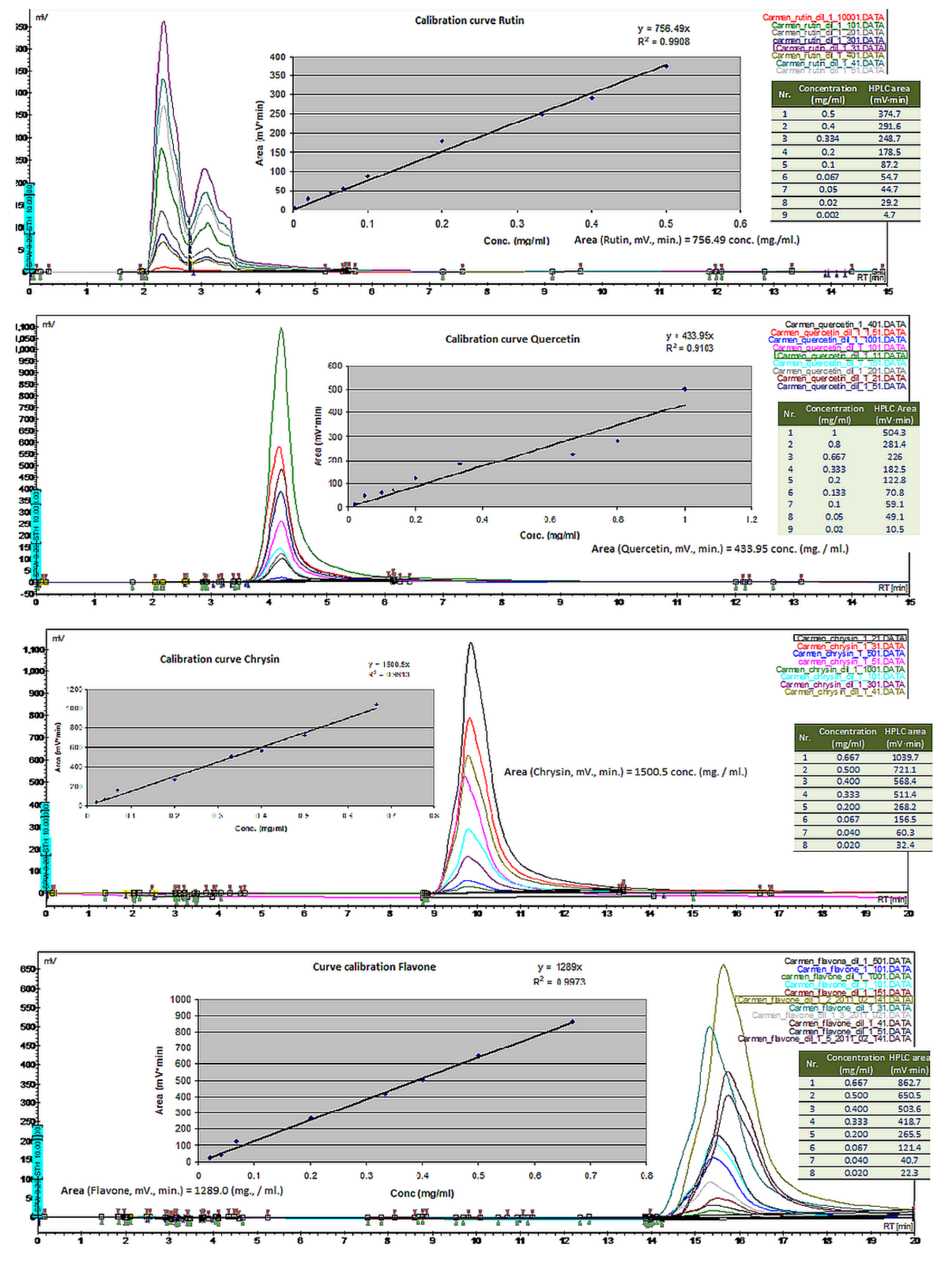
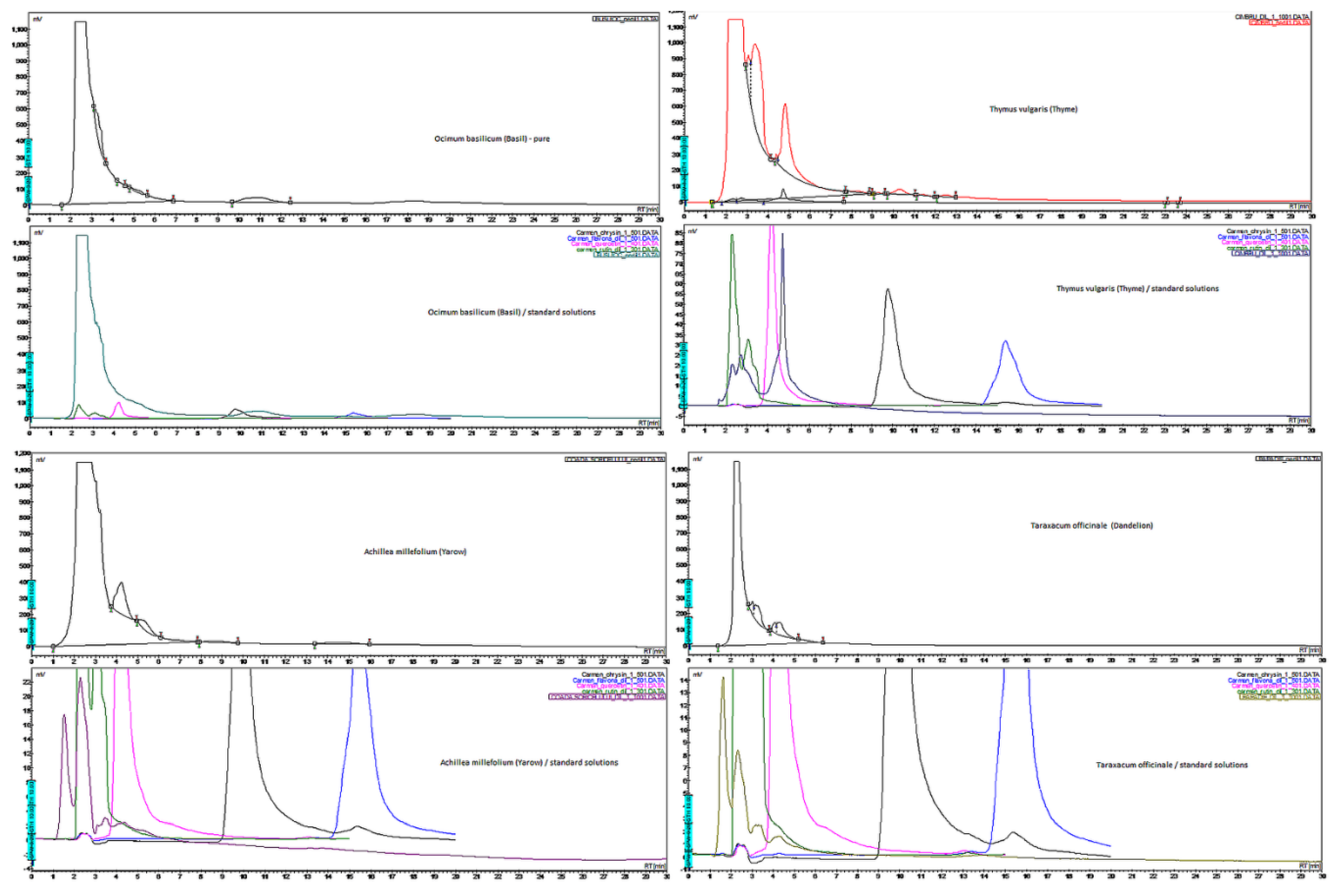
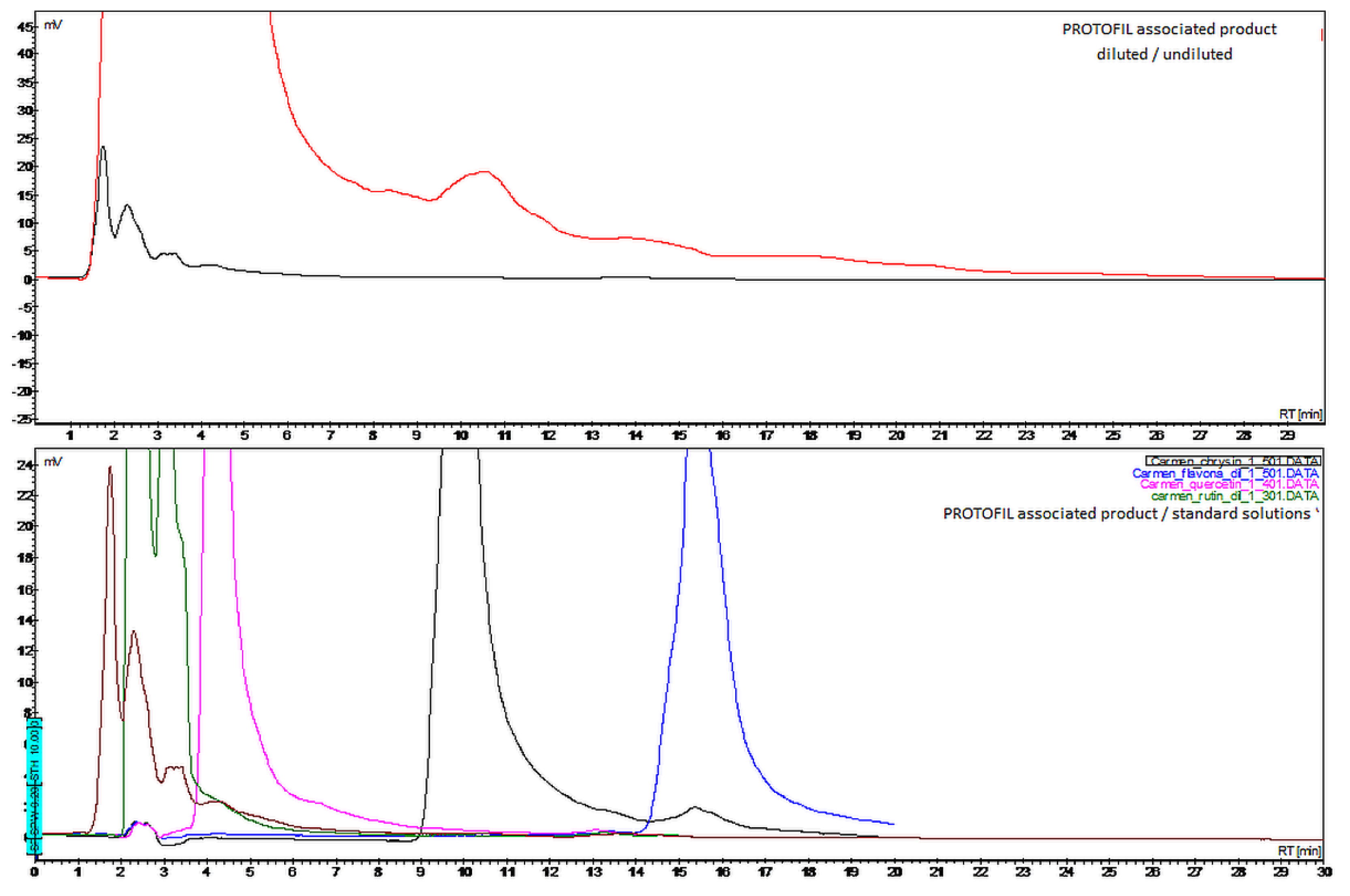
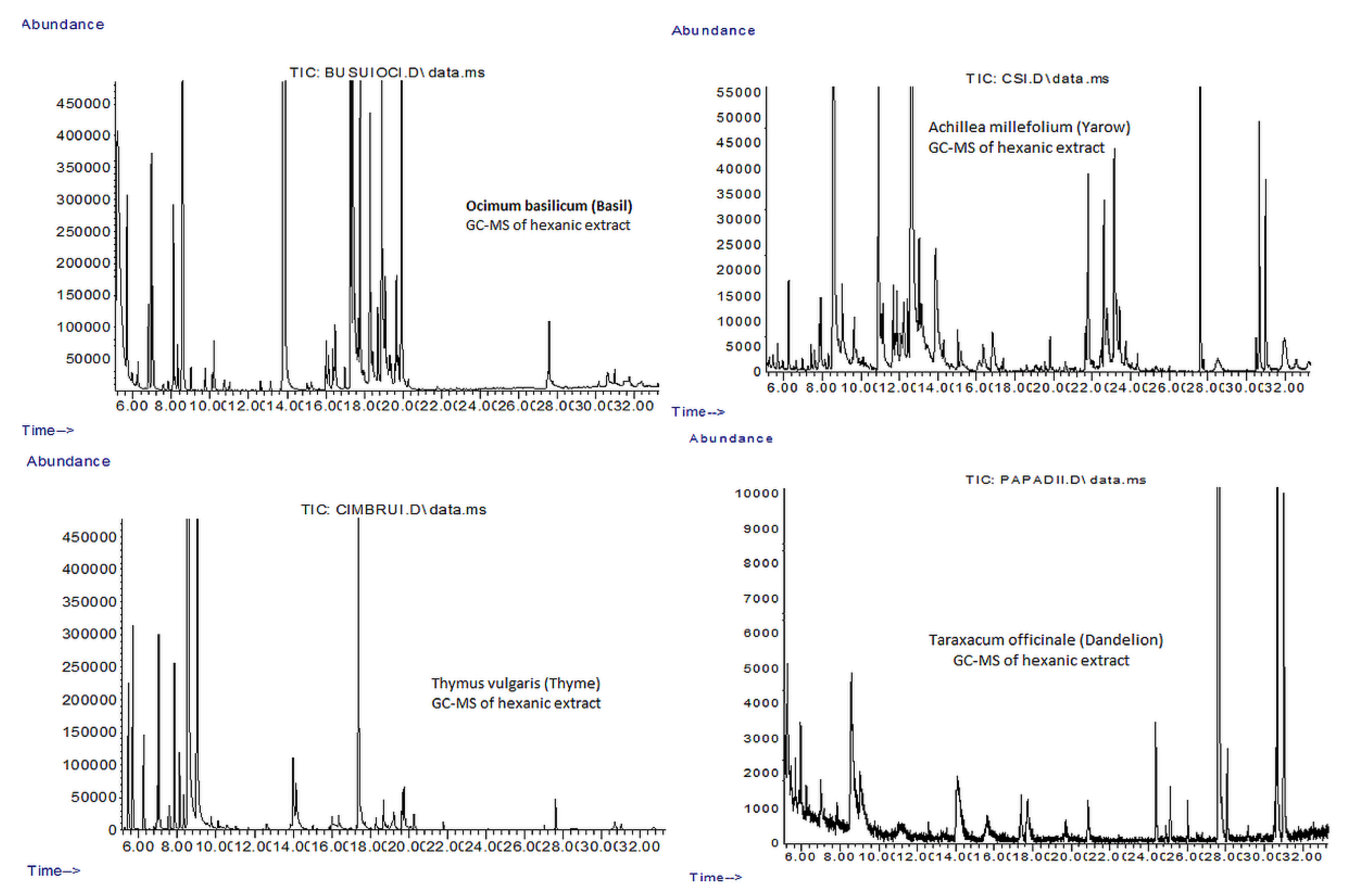
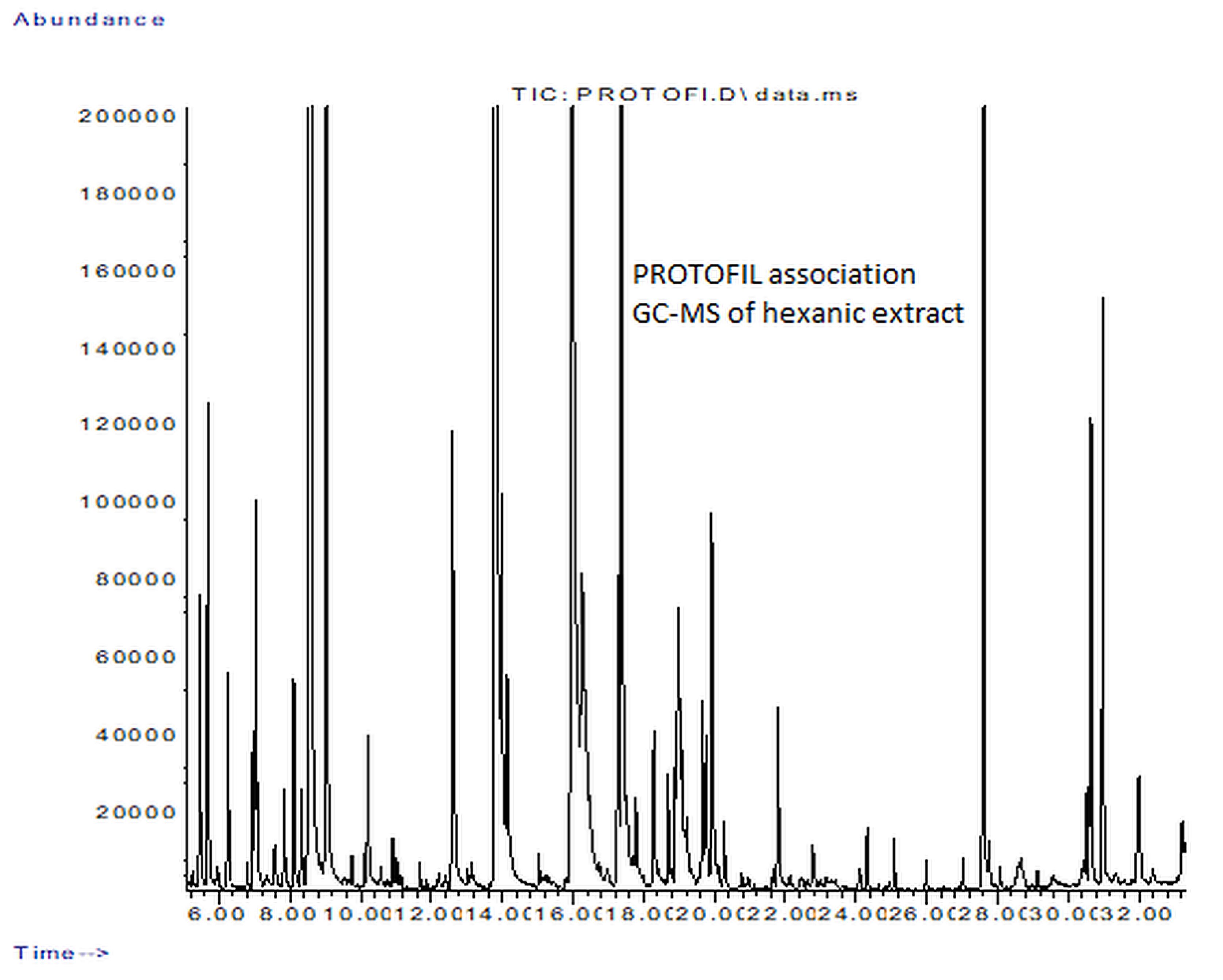
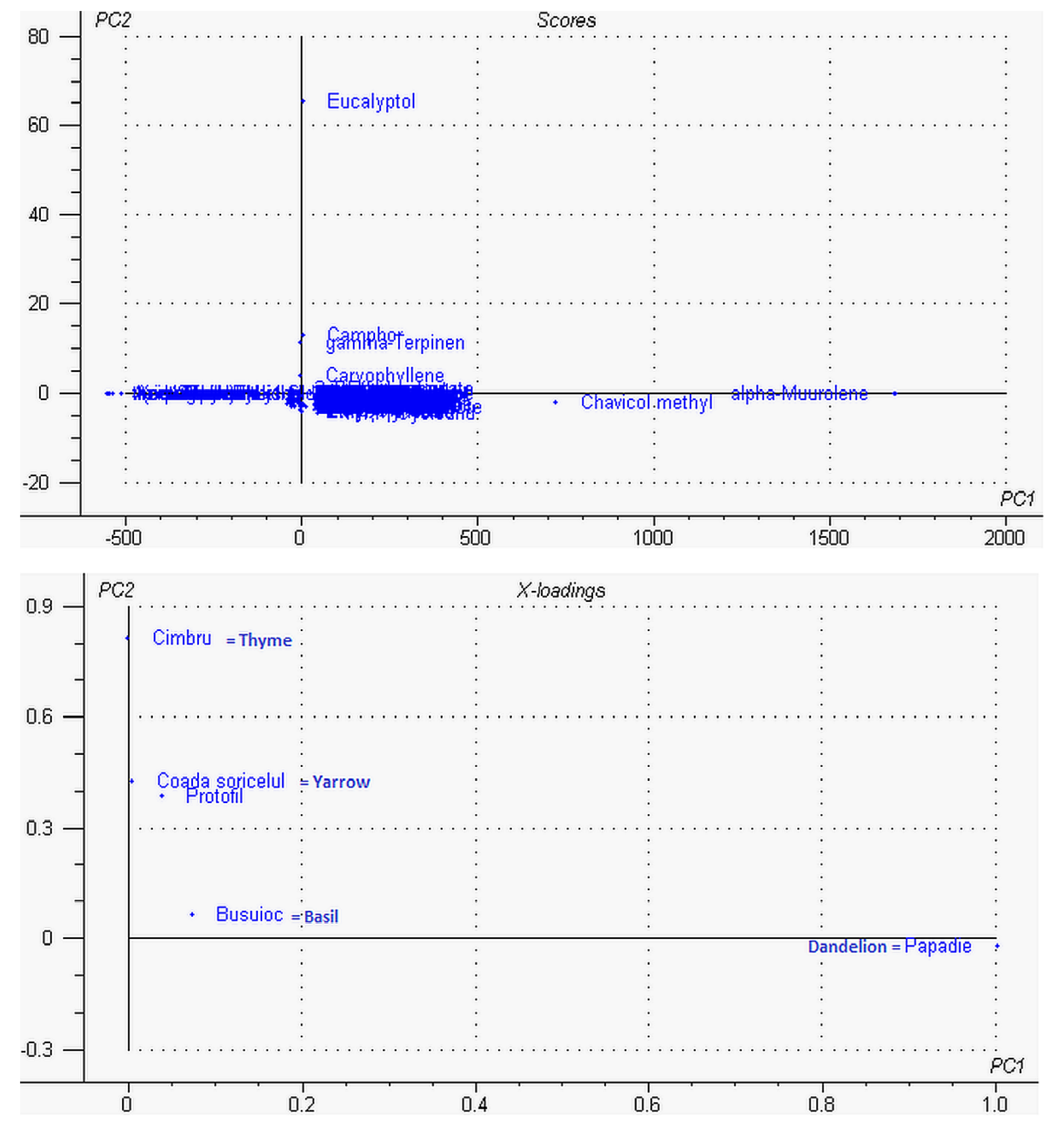
| Nr. | Compound | RT (min) | Conc. (Ba) (mg/mL) | Conc. (Th) (mg/mL) | Conc. (Ya) (mg/mL) | Conc. (Da) (mg/mL) | Conc. (PF) (mg/mL) |
|---|---|---|---|---|---|---|---|
| 1 | Rutin | 2–3.6 | 1.843 | 3.437 | 2.543 | 1.049 | 1.540 |
| 2 | Quercetin | 4.2 | 0.017 | 9.379 | 0.232 | 0.029 | 0.061 |
| 3 | Chrysene | 9.8 | 0.027 | 0.012 | 0.004 | 0.000 | 0.007 |
| 4 | Flavone | 15.8 | 0.000 | 0.000 | 0.010 | 0.016 | 0.002 |
| No. | A Compound Identified by GC-MS | RT (min) | Kovats Index | Relative Concentration (%) |
|---|---|---|---|---|
| 1 | Column | 5.198 | 948 | 0.00 |
| 2 | alpha-Pinene | 5.686 | 974 | 1.29 |
| 3 | Column | 5.944 | 987 | 0.00 |
| 4 | Column | 6.173 | 999 | 0.00 |
| 5 | Camphene | 6.250 | 1002 | 0.15 |
| 6 | beta-Phellandrene | 6.796 | 1028 | 0.50 |
| 7 | beta-Pinene | 6.955 | 1035 | 1.42 |
| 8 | Sabinen/beta-pinene | 7.037 | 1039 | 0.64 |
| 9 | Bicyclo [3.1.0]hexane, 4-methyl-1-(1-methylethyl)-, didehydro | 7.584 | 1063 | 0.05 |
| 10 | Terpinolen | 7.830 | 1074 | 0.06 |
| 11 | Limonene | 8.101 | 1086 | 1.10 |
| 12 | Dihydrocarveol | 8.195 | 1090 | 0.08 |
| 13 | 3-Carene/alpha-pinene | 8.318 | 1095 | 0.27 |
| 14 | Eucalyptol | 8.582 | 1106 | 7.31 |
| 15 | gamma-Terpinen | 9.005 | 1124 | 0.14 |
| 16 | Terpinolen | 9.740 | 1155 | 0.13 |
| 17 | 2-Cyclohexen-1-ol, 1-methyl-4-(1-methylethyl)-, cis- | 10.116 | 1171 | 0.09 |
| 18 | Linalool | 10.192 | 1174 | 0.31 |
| 19 | Fenchone | 10.739 | 1198 | 0.08 |
| 20 | Tetrahydroactinidiolide | 11.015 | 1210 | 0.05 |
| 21 | Camphor | 12.607 | 1280 | 0.08 |
| 22 | Caprylyl acetate | 12.683 | 1283 | 0.02 |
| 23 | Fenchyl acetate | 13.136 | 1303 | 0.05 |
| 24 | Chavicol methyl ether | 13.870 | 1337 | 54.91 |
| 25 | Bornyl acetate | 15.034 | 1391 | 0.04 |
| 26 | alpha-Cubebene | 15.239 | 1400 | 0.04 |
| 27 | Copaene | 16.015 | 1437 | 0.30 |
| 28 | Di-epi-alpha-cedrene | 16.138 | 1443 | 0.28 |
| 29 | beta-Bourbonene | 16.362 | 1454 | 0.24 |
| 30 | beta-Elemene | 16.479 | 1459 | 0.58 |
| 31 | alpha-Bergamotene | 16.984 | 1484 | 0.15 |
| 32 | alpha-Bergamotene | 17.290 | 1498 | 5.79 |
| 33 | Caryophyllene | 17.401 | 1504 | 6.75 |
| 34 | trans-Caryophyllene/Isocaryophyllene | 17.684 | 1518 | 0.25 |
| 35 | beta-Farnesene | 17.778 | 1522 | 1.74 |
| 36 | Humulene | 18.300 | 1548 | 1.88 |
| 37 | gamma-Muurolene | 18.436 | 1555 | 0.22 |
| 38 | (Z)-beta-Farnesene | 18.706 | 1568 | 0.48 |
| 39 | Germacrene D | 18.906 | 1578 | 3.41 |
| 40 | alpha-Himachalene | 19.088 | 1587 | 0.54 |
| 41 | Eremophilene | 19.293 | 1598 | 0.11 |
| 42 | Elixene | 19.358 | 1601 | 0.23 |
| 43 | beta-Cedrene | 19.599 | 1613 | 0.10 |
| 44 | gamma-Cadinene | 19.658 | 1616 | 0.75 |
| 45 | beta-Cadinene | 19.758 | 1621 | 0.19 |
| 46 | 1,4,7,-Cycloundecatriene, 1,5,9,9-tetramethyl-, Z,Z,Z- | 19.928 | 1630 | 6.33 |
| 47 | Calamenene | 20.275 | 1648 | 0.09 |
| 48 | Caryophyllene oxide | 21.790 | 1728 | 0.02 |
| 49 | Palmitic acid | 27.519 | 2068 | 0.15 |
| 50 | Ethyl palmitate | 27.584 | 2072 | 0.41 |
| 51 | Column | 30.163 | 2262 | 0.00 |
| 52 | Arachidic acid | 30.598 | 2299 | 0.10 |
| 53 | Ethyl linolenate | 30.980 | 2333 | 0.08 |
| 54 | Column | 31.755 | 2407 | 0.00 |
| 55 | Column | 32.214 | 2456 | 0.00 |
| 56 | Column | 33.230 | 2577 | 0.00 |
| No. | A Compound Identified by GC-MS | RT (min) | Kovats Index | Relative Concentration (%) |
|---|---|---|---|---|
| 1 | solvent | 5.254 | 951 | 0.00 |
| 2 | alpha-Thujene | 5.454 | 962 | 2.06 |
| 3 | alpha-Pinene | 5.683 | 974 | 2.94 |
| 4 | Camphene | 6.247 | 1002 | 1.39 |
| 5 | beta-Terpinen | 6.8 | 1028 | 0.05 |
| 6 | beta-Pinene | 6.952 | 1035 | 0.58 |
| 7 | beta-Pinene | 7.035 | 1039 | 2.51 |
| 8 | alpha-Thujene | 7.581 | 1063 | 0.43 |
| 9 | alpha-Terpinen | 7.828 | 1074 | 2.14 |
| 10 | Limonene | 8.104 | 1086 | 0.99 |
| 11 | beta-Phellandrene | 8.321 | 1095 | 0.45 |
| 12 | Eucalyptol | 8.556 | 1105 | 57.63 |
| 13 | gamma-Terpinen | 9.015 | 1124 | 15.03 |
| 14 | Terpinolen | 9.743 | 1155 | 0.19 |
| 15 | 2-Cyclohexen-1-ol, 1-methyl-4-(1-methylethyl)-, cis- | 10.113 | 1171 | 0.11 |
| 16 | Dehydro-p-cymene | 10.583 | 1191 | 0.11 |
| 17 | 2-Cyclohexen-1-ol, 1-methyl-4-(1-methylethyl)-, cis- | 11.018 | 1210 | 0.06 |
| 18 | 2-Cyclohexen-1-ol, 1-methyl-4-(1-methylethyl)-, cis- | 12.616 | 1280 | 0.18 |
| 19 | Methyl chavicol | 13.874 | 1337 | 0.14 |
| 20 | Thymol methyl ether | 13.991 | 1342 | 1.68 |
| 21 | 2-Isopropyl-1-methoxy-4-methylbenzene | 14.15 | 1350 | 1.61 |
| 22 | Bornyl acetate | 15.031 | 1391 | 0.06 |
| 23 | Ylangene | 15.883 | 1431 | 0.06 |
| 24 | Copaene | 16.012 | 1437 | 0.20 |
| 25 | beta-Bourbonene | 16.359 | 1453 | 0.14 |
| 26 | Ylangene | 17.293 | 1499 | 0.07 |
| 27 | Caryophyllene | 17.387 | 1503 | 5.10 |
| 28 | Alloaromadendren | 17.716 | 1519 | 0.15 |
| 29 | Humulene | 18.292 | 1548 | 0.20 |
| 30 | gamma-Muurolene | 18.686 | 1567 | 0.48 |
| 31 | alpha-Muurolene | 18.803 | 1573 | 0.07 |
| 32 | Germacrene D | 18.903 | 1578 | 0.07 |
| 33 | alpha-Muurolene | 19.22 | 1594 | 0.57 |
| 34 | gamma-Cadinene | 19.661 | 1617 | 0.61 |
| 35 | beta-Cadinene | 19.761 | 1622 | 0.76 |
| 36 | alpha-Muurolene | 20.107 | 1639 | 0.07 |
| 37 | Calamenene | 20.272 | 1648 | 0.30 |
| 38 | Caryophyllene oxide | 21.788 | 1728 | 0.15 |
| 39 | 5,9,9-Trimethyl-spiro[3.5]non-5-en-1-one | 27.029 | 2035 | 0.06 |
| 40 | Palmitic acid, ethyl ester | 27.605 | 2073 | 0.49 |
| 41 | Cholesterol, trifluoroacetate | 30.677 | 2306 | 0.00 |
| 42 | Linolenic acid, methyl ester | 31.006 | 2335 | 0.11 |
| 43 | 2,4,4,6,6,8,8-Heptamethyl-1-nonene | 32.699 | 2511 | 0.00 |
| No. | A Compound Identified by GC-MS | RT (min) | Kovats Index | Relative Concentration (%) |
|---|---|---|---|---|
| 1 | alpha-Pinene | 5.681 | 974 | 0.22 |
| 2 | Camphene | 6.251 | 1002 | 0.78 |
| 3 | Yomogi alcohol | 7.42 | 1056 | 0.26 |
| 4 | 3-Thujene | 7.59 | 1063 | 0.17 |
| 5 | Terpinolen | 7.837 | 1074 | 0.46 |
| 6 | 4-Oxo-beta-isodamascol | 7.913 | 1077 | 0.62 |
| 7 | beta-Terpinen | 8.319 | 1095 | 0.17 |
| 8 | Eucalyptol | 8.577 | 1106 | 25.14 |
| 9 | 2-Carene | 9.012 | 1124 | 1.12 |
| 10 | 2-Norpinanol, 3,6,6-trimethyl- | 9.652 | 1151 | 0.43 |
| 11 | 3-Thujanone | 10.91 | 1205 | 3.17 |
| 12 | Isopulegol | 11.021 | 1210 | 0.69 |
| 13 | alpha-Thujone | 11.133 | 1215 | 0.79 |
| 14 | 4-Oxo-beta-isodamascol | 11.679 | 1239 | 0.85 |
| 15 | cis-Sabinol | 11.779 | 1243 | 0.37 |
| 16 | Verbenyl ethyl ether | 11.867 | 1247 | 0.79 |
| 17 | Lavandulol | 12.061 | 1255 | 0.57 |
| 18 | Lavandulol | 12.208 | 1262 | 0.79 |
| 19 | 4-Oxo-beta-isodamascol | 12.42 | 1271 | 0.58 |
| 20 | Camphor | 12.596 | 1279 | 37.52 |
| 21 | E-3,5-Dimethylhex-2-en-1,2-dicarboxylic acid | 13.031 | 1299 | 1.25 |
| 22 | Isobornyl formate | 13.142 | 1304 | 1.01 |
| 23 | Chavicol methyl ether | 13.877 | 1337 | 3.27 |
| 24 | trans-Chrysanthenyl Acetate | 14.288 | 1356 | 0.21 |
| 25 | Isobornyl acetate | 15.028 | 1390 | 0.35 |
| 26 | cis-Carvyl Acetate | 16.345 | 1453 | 0.36 |
| 27 | Capric acid, ethyl ester | 16.82 | 1476 | 1.13 |
| 28 | 9-Cedranone | 19.811 | 1624 | 0.34 |
| 29 | Spathulenol | 21.656 | 1721 | 0.45 |
| 30 | Caryophyllene oxide | 21.785 | 1728 | 1.95 |
| 31 | 2-Cyclohexene-1-carboxaldehyde,2,6-dimethyl-6-(4-methyl-3-pentenyl) | 22.437 | 1763 | 0.16 |
| 32 | 4(equatorial)-n-Propyl-trans-3-oxabicyclo[4.4.0]decane | 22.496 | 1766 | 0.21 |
| 33 | gamma-Eudesmol | 22.614 | 1773 | 1.94 |
| 34 | beta-Guaiene | 22.772 | 1782 | 0.58 |
| 35 | alpha-Eudesmol | 23.148 | 1803 | 2.47 |
| 36 | Humulane-1,6-dien-3-ol | 23.425 | 1818 | 0.78 |
| 37 | Aristolone | 23.742 | 1836 | 0.24 |
| 38 | Ethyl myristate | 24.347 | 1871 | 0.16 |
| 39 | Palmitic acid, ethyl ester | 27.602 | 2073 | 3.37 |
| 40 | Ethyl Oleate | 30.504 | 2291 | 0.28 |
| 41 | Linoleic acid ethyl ester | 30.663 | 2305 | 2.19 |
| 42 | Ethyl linolenate | 30.992 | 2334 | 1.79 |
| 43 | Column | 31.962 | 2429 | 0.00 |
| 44 | Column | 32.584 | 2498 | 0.00 |
| No. | A Compound Identified by GC-MS | RT (min) | Kovats Index | Relative Concentration (%) |
|---|---|---|---|---|
| 1 | Bicyclo[2.1.1]hexan-2-ol, 2-ethenyl- | 5.146 | 945 | 0.59 |
| 2 | p-Xylene | 5.252 | 951 | 2.42 |
| 3 | Octane, 1-chloro- | 5.458 | 962 | 0.43 |
| 4 | alpha-Thujene | 5.693 | 975 | 0.53 |
| 5 | Isovaleraldehyde, diethyl acetal | 5.945 | 987 | 1.72 |
| 6 | Linalyl propionate | 6.239 | 1002 | 0.64 |
| 7 | Pentane, 1,1-diethoxy- | 7.003 | 1037 | 1.41 |
| 8 | Eucalyptol | 8.572 | 1106 | 5.72 |
| 9 | trans-Verbenol | 9.03 | 1125 | 0.40 |
| 10 | Chavicol methyl ether | 14.012 | 1343 | 0.46 |
| 11 | Bicyclo[2.2.1]heptane, 2-cyclopropylidene-1,7,7-trimethyl- | 17.385 | 1503 | 0.66 |
| 12 | 2,3-Dehydro-4-oxo-beta-ionone | 19.688 | 1618 | 0.50 |
| 13 | Ethyl laurate | 20.863 | 1679 | 1.15 |
| 14 | Ethyl myristate | 24.371 | 1872 | 2.17 |
| 15 | Oxirane, 2-methyl-2-(1-methylethyl)- | 25.117 | 1916 | 0.93 |
| 16 | Methyl 2-methylhexanoate | 26.016 | 1971 | 0.71 |
| 17 | Ethyl palmitate | 27.614 | 2074 | 62.49 |
| 18 | Eicosane | 28.084 | 2106 | 1.31 |
| 19 | 2,6-Pyrazinediamine | 30.522 | 2292 | 0.55 |
| 20 | Ethyl stearate | 30.622 | 2301 | 1.02 |
| 21 | Ethyl linolate | 30.687 | 2307 | 8.13 |
| 22 | Methyl linolenate | 31.016 | 2336 | 6.06 |
| No. | A Compound Identified by GC-MS | RT (min) | Kovats Index | Relative Concentration (%) |
|---|---|---|---|---|
| 1 | p-Xylene | 5.253 | 951 | 0.05 |
| 2 | 1-Isopropyl-4-methylbicyclo[3.1.0]hex-2-ene/alpha-Phellandrene | 5.458 | 962 | 0.72 |
| 3 | alpha-Pinene | 5.687 | 974 | 1.20 |
| 4 | Valeraldehyde, diethyl acetal | 5.946 | 988 | 0.07 |
| 5 | Camphene | 6.252 | 1003 | 0.56 |
| 6 | beta-Terpinen | 6.798 | 1028 | 0.07 |
| 7 | beta-Pinene | 6.957 | 1035 | 0.39 |
| 8 | beta-Pinene | 7.039 | 1039 | 0.95 |
| 9 | 3-Carene | 7.585 | 1063 | 0.15 |
| 10 | alpha-Terpinen | 7.832 | 1074 | 0.24 |
| 11 | Limonene | 8.102 | 1086 | 0.55 |
| 12 | beta-Phellandrene | 8.32 | 1095 | 0.24 |
| 13 | Eucalyptol | 8.531 | 1104 | 28.61 |
| 14 | gamma-Terpinen | 9.013 | 1124 | 5.86 |
| 15 | Terpinolene | 9.747 | 1155 | 0.10 |
| 16 | 4-Isopropyl-1-methyl-2-cyclohexene-1-ol | 10.118 | 1171 | 0.08 |
| 17 | Linalool | 10.2 | 1175 | 0.44 |
| 18 | 3,4-Dimethylstyrene | 10.57 | 1190 | 0.08 |
| 19 | Thujone | 10.911 | 1205 | 0.12 |
| 20 | 4-Isopropyl-1-methyl-2-cyclohexene-1-ol | 11.022 | 1210 | 0.07 |
| 21 | 4-Oxo-beta-isodamascol | 11.68 | 1239 | 0.06 |
| 22 | 1,3-Dioxolane, 2,2-dimethyl-4,5-bis(1-methyl phenyl)- | 12.209 | 1262 | 0.05 |
| 23 | Tetrahydroactinidiolide | 12.415 | 1271 | 0.04 |
| 24 | Camphor | 12.597 | 1279 | 1.73 |
| 25 | E-3,5-Dimethylhex-2-en-1,2-dicarboxylic acid | 13.026 | 1298 | 0.04 |
| 26 | alpha-Terpineol | 13.138 | 1304 | 0.07 |
| 27 | Chavicol methyl ether | 13.784 | 1333 | 28.09 |
| 28 | Thymol methyl ether | 13.978 | 1342 | 1.43 |
| 29 | 2-Isopropyl-1-methoxy-4-methylbenzene | 14.136 | 1349 | 0.80 |
| 30 | Bornyl acetate | 15.035 | 1391 | 0.09 |
| 31 | Thymol | 15.799 | 1427 | 0.05 |
| 32 | Thymol | 15.958 | 1434 | 7.19 |
| 33 | Carvacrol | 16.252 | 1448 | 0.77 |
| 34 | Carvacrol | 16.739 | 1472 | 0.06 |
| 35 | 1-Cyclopropene-1-pentanol, à,î,î,2-tetramethyl-3-(1-methyl phenyl)- | 16.992 | 1484 | 0.07 |
| 36 | alpha-Bergamotene | 17.274 | 1498 | 0.89 |
| 37 | Caryophyllene | 17.386 | 1503 | 3.29 |
| 38 | beta-Farnesene | 17.785 | 1523 | 0.27 |
| 39 | Humulene | 18.296 | 1548 | 0.49 |
| 40 | gamma-Muurolene | 18.696 | 1568 | 0.34 |
| 41 | Germacrene D | 18.901 | 1578 | 0.35 |
| 42 | Eugenol methyl ether | 18.978 | 1582 | 0.83 |
| 43 | gamma-Cadinene | 19.659 | 1616 | 0.48 |
| 44 | beta-Cadinene | 19.759 | 1622 | 0.40 |
| 45 | cis-alpha-Bisabolene | 19.924 | 1630 | 1.21 |
| 46 | Calamenene | 20.27 | 1648 | 0.22 |
| 47 | Ethyl laurate | 20.764 | 1674 | 0.05 |
| 48 | Cadala-1(10),3,8-triene | 20.952 | 1683 | 0.04 |
| 49 | Spathulenol | 21.657 | 1721 | 0.07 |
| 50 | Caryophyllene oxide | 21.792 | 1728 | 0.55 |
| 51 | delta-Cadinol | 22.127 | 1746 | 0.06 |
| 52 | 12-Oxabicyclo[9.1.0]dodeca-3,7-diene, 1,5,5,8-tetramethyl-, [1R-(1R | 22.444 | 1764 | 0.05 |
| 53 | Cubenol | 22.626 | 1774 | 0.04 |
| 54 | tau-Cadinol | 22.779 | 1782 | 0.16 |
| 55 | Cadalene | 24.113 | 1858 | 0.08 |
| 56 | Ethyl myristate | 24.324 | 1870 | 0.15 |
| 57 | Hexahydrofarnesyl acetone | 25.082 | 1914 | 0.12 |
| 58 | Ethyl pentadecanoate | 25.987 | 1969 | 0.08 |
| 59 | Naphthalene, 1,2,3,4,4a,5,6,7-octahydro-4a-methyl- | 27.027 | 2035 | 0.08 |
| 60 | Ethyl palmitate | 27.591 | 2072 | 4.45 |
| 61 | Ethyl (9E)-9-hexadecenoate | 27.762 | 2084 | 0.13 |
| 62 | Nonadecane | 28.061 | 2104 | 0.05 |
| 63 | cyclopentane carboxylic acid, 4-hexadecyl ester | 28.672 | 2147 | 0.08 |
| 64 | Ethyl heptadecanoate | 29.125 | 2181 | 0.04 |
| 65 | 2-Piperidinone, N-[4-bromo-n-butyl]- | 29.565 | 2214 | 0.06 |
| 66 | 4-Butoxy-2,4-dimethyl-2-pentene | 30.411 | 2283 | 0.08 |
| 67 | Ethyl Oleate | 30.494 | 2290 | 0.20 |
| 68 | Ethyl stearate | 30.594 | 2298 | 0.20 |
| 69 | 9,12-Octadecadienoic acid, ethyl ester | 30.652 | 2304 | 1.06 |
| 70 | Linolenic acid, ethyl ester | 30.981 | 2333 | 1.37 |
| 71 | Linolenic acid, ethyl ester | 31.357 | 2368 | 0.05 |
| 72 | 2,4,4,6,6,8,8-Heptamethyl-2-nonene | 31.998 | 2433 | 0.57 |
| 73 | (Z)-7-Hexadecenal | 32.403 | 2477 | 0.04 |
| 74 | 2,4,4,6,6,8,8-Heptamethyl-1-nonene | 33.226 | 2577 | 0.26 |
© 2020 by the authors. Licensee MDPI, Basel, Switzerland. This article is an open access article distributed under the terms and conditions of the Creative Commons Attribution (CC BY) license (http://creativecommons.org/licenses/by/4.0/).
Share and Cite
Cristina, R.T.; Kovačević, Z.; Cincović, M.; Dumitrescu, E.; Muselin, F.; Imre, K.; Militaru, D.; Mederle, N.; Radulov, I.; Hădărugă, N.; et al. Composition and Efficacy of a Natural Phytotherapeutic Blend against Nosemosis in Honey Bees. Sustainability 2020, 12, 5868. https://doi.org/10.3390/su12145868
Cristina RT, Kovačević Z, Cincović M, Dumitrescu E, Muselin F, Imre K, Militaru D, Mederle N, Radulov I, Hădărugă N, et al. Composition and Efficacy of a Natural Phytotherapeutic Blend against Nosemosis in Honey Bees. Sustainability. 2020; 12(14):5868. https://doi.org/10.3390/su12145868
Chicago/Turabian StyleCristina, Romeo Teodor, Zorana Kovačević, Marko Cincović, Eugenia Dumitrescu, Florin Muselin, Kalman Imre, Dumitru Militaru, Narcisa Mederle, Isidora Radulov, Nicoleta Hădărugă, and et al. 2020. "Composition and Efficacy of a Natural Phytotherapeutic Blend against Nosemosis in Honey Bees" Sustainability 12, no. 14: 5868. https://doi.org/10.3390/su12145868
APA StyleCristina, R. T., Kovačević, Z., Cincović, M., Dumitrescu, E., Muselin, F., Imre, K., Militaru, D., Mederle, N., Radulov, I., Hădărugă, N., & Puvača, N. (2020). Composition and Efficacy of a Natural Phytotherapeutic Blend against Nosemosis in Honey Bees. Sustainability, 12(14), 5868. https://doi.org/10.3390/su12145868










